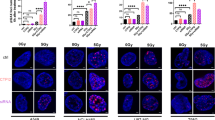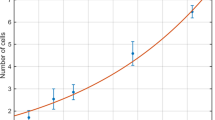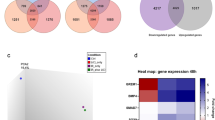Abstract
Aim:
Cathepsin L is a lysosomal cysteine protease that plays important roles in cancer tumorigenesis, proliferation and chemotherapy resistance. The aim of this study was to determine how cathepsin L regulated the radiosensitivity of human glioma cells in vitro.
Methods:
Human glioma U251 cells (harboring the mutant type p53 gene) and U87 cells (harboring the wide type p53 gene) were irradiated with X-rays. The expression of cathepsin L was analyzed using Western blot and immunofluorescence assays. Cell survival and DNA damage were evaluated using clonogenic and comet assays, respectively. Flow cytometry was used to detect the cell cycle distribution. Apoptotic cells were observed using Hoechst 33258 staining and fluorescence microscopy.
Results:
Irradiation significantly increased the cytoplasmic and nuclear levels of cathepsin L in U251 cells but not in U87 cells. Treatment with the specific cathepsin L inhibitor Z-FY-CHO (10 μmol/L) or transfection with cathepsin L shRNA significantly increased the radiosensitivity of U251 cells. Both suppression and knockdown of cathepsin L in U251 cells increased irradiation-induced DNA damage and G2/M phase cell cycle arrest. Both suppression and knockdown of cathepsin L in U251 cells also increased irradiation-induced apoptosis, as shown by the increased levels of Bax and decreased levels of Bcl-2.
Conclusion:
Cathepsin L is involved in modulation of radiosensitivity in human glioma U251 cells (harboring the mutant type p53 gene) in vitro.
Similar content being viewed by others
Log in or create a free account to read this content
Gain free access to this article, as well as selected content from this journal and more on nature.com
or
References
Gauden AJ, Hunn A, Erasmus A, Waites P, Dubey A, Guaden SJ . Combined modality treatment of newly diagnosed glioblastoma multiforme in a regional neurosurgical centre. J Clin Neurosci 2009; 16: 1174–9.
Nakai K, Yamamoto T, Aiyama H, Takada T, Yoshida F, Kageji T, et al. Boron neutron capture therapy combined with fractionated photon irradiation for glioblastoma: a recursive partitioning analysis of BNCT patients. Appl Radiat Isot 2011; 69: 1790–2.
Shen Y, Wang Y, Sheng K, Fei X, Guo Q, Larner J, et al. Serine/threonine protein phosphatase 6 modulates the radiation sensitivity of glioblastoma. Cell Death Dis 2011; 2: e241.
Turk D, Guncar G . Lysosomal cysteine proteases (cathepsins): promising drug targets. Acta Crystallogr D Biol Crystallogr 2003; 59: 203–13.
Turk V, Stoka V, Vasiljeva O, Renko M, Sun T, Turk B, et al. Cysteine cathepsins: from structure, function and regulation to new frontiers. Biochim Biophys Acta 2012; 1824: 68–88.
Felbor U, Kessler B, Mothes W, Goebel HH, Ploegh HL, Bronson RT, et al. Neuronal loss and brain atrophy in mice lacking cathepsins B and L. Proc Natl Acad Sci U S A 2002; 99: 7883–8.
Fei XF, Qin ZH, Xiang B, Li LY, Han F, Fukunaga K, et al. Olomoucine inhibits cathepsin L nuclear translocation, activates autophagy and attenuates toxicity of 6-hydroxydopamine. Brain Res 2009; 1264: 85–97.
Gocheva V, Zeng W, Ke D, Klimstra D, Reinheckel T, Peters C, et al. Distinct roles for cysteine cathepsin genes in multistage tumorigenesis. Genes Dev 2006; 20: 543–56.
Maehr R, Mintern JD, Herman AE, Lennon-Duménil AM, Mathis D, Benoist C, et al. Cathepsin L is essential for onset of autoimmune diabetes in NOD mice. J Clin Invest 2005; 115: 2934–43.
Mohamed MM, Sloane BF . Cysteine cathepsins: multifunctional enzymes in cancer. Nat Rev Cancer 2006; 6: 764–75.
Simmons G, Gosalia DN, Rennekamp AJ, Reeves JD, Diamond SL, Bates P . Inhibitors of cathepsin L prevent severe acute respiratory syndrome coronavirus entry. Proc Natl Acad Sci U S A 2005; 102: 11876–81.
Xiang B, Fei X, Zhuang W, Fang Y, Qin Z, Liang Z . Cathepsin L is involved in 6-hydroxydopamine induced apoptosis of SH-SY5Y neuroblastoma cells. Brain Res 2011; 1387: 29–38.
Lankelma JM, Voorend DM, Barwari T, Koetsveld J, Van der Spek AH, De Porto AP, et al. Cathepsin L, target in cancer treatment? Life Sci 2010; 86: 225–33.
Navab R, Pedraza C, Fallavollita L, Wang N, Chevet E, Auguste P, et al. Loss of responsiveness to IGF-I in cells with reduced cathepsin L expression levels. Oncogene 2008; 27: 4973–85.
Pucer A, Castino R, Mirković B, Falnoga I, Slejkovec Z, Isidoro C, et al. Differential role of cathepsins B and L in Autophagy-associated cell death induced by arsenic trioxide in U87 human glioblastoma cells. Biol Chem 2010; 391: 519–31.
Zajc I, Hreljac I, Lah T . Cathepsin L affects apoptosis of glioblastoma cells: a potential implication in the design of cancer therapeutics. Anticancer Res 2006; 26: 3357–64.
Di Piazza M, Mader C, Geletneky K, Herrero Y Calle M, Weber E, Schlehofer J, et al. Cytosolic activation of cathepsins mediates parvovirus H-1-induced killing of cisplatin and TRAIL-resistant glioma cells. J Virol 2007; 81: 4186–98.
Hsu KF, Wu CL, Huang SC, Wu CM, Hsiao JR, Yo YT, et al. Cathepsin L mediates resveratrol-induced autophagy and apoptotic cell death in cervical cancer cells. Autophagy 2009; 5: 451–60.
Rebbaa A . Targeting senescence pathways to reverse drug resistance in cancer. Cancer Lett 2005; 219: 1–13.
Zheng X, Chou PM, Mirkin BL, Rebbaa A . Senescence-initiated reversal of drug resistance: specific role of cathepsin L. Cancer Res 2004; 64: 1773–80.
Zheng X, Chu F, Chou PM, Gallati C, Dier U, Mirkin BL, et al. Cathepsin L inhibition suppresses drug resistance in vitro and in vivo: a putative mechanism. Am J Physiol Cell Physiol 2009; 296: C65–C74.
Katara R, Mir RA, Shukla AA, Tiwari A, Singh N, Chauhan SS . Wild type p53-dependent transcriptional upregulation of cathepsin L expression is mediated by C/EBPα in human glioblastoma cells. Biol Chem 2010; 391: 1031–40.
Goulet B, Sansregret L, Leduy L, Bogyo M, Weber E, Chauhan SS, et al. Increased expression and activity of nuclear cathepsin L in cancer cells suggests a novel mechanism of cell transformation. Mol Cancer Res 2007; 5: 899–907.
Cuddihy AR, Jalali F, Coackley C, Bristow RG . WTp53 induction does not override MTp53 chemoresistance and radioresistance due to gain-of-function in lung cancer cells. Mol Cancer Ther 2008; 7: 980–92.
Dote H, Burgan WE, Camphausen K . Inhibition of Hsp90 compromises the DNA damage response to radiation. Cancer Res 2006; 66: 9211–20.
Vandersickel V, Depuydt J, Van Bockstaele B, Perletti G, Philippe J, Thierens H, et al. Early increase of radiation-induced γH2AX foci in a human Ku70/80 knockdown cell line characterized by an enhanced radiosensitivity. J Radiat Res 2010; 51: 633–41.
Li Z, Owonikoko TK, Sun SY, Ramalingam SS, Doetsch PW, Xiao ZQ, et al. c-Myc suppression of DNA double-strand break repair. Neoplasia 2012; 14: 1190–202.
Shahi A, Lee JH, Kang Y, Lee SH, Hyun JW, Chang IY, et al. Mismatch-repair protein MSH6 is associated with Ku70 and regulates DNA double-strand break repair. Nucleic Acids Res 2011; 39: 2130–43.
Iwata T, Shimada M, Kurita N, Nishioka M, Morimoto S, Yoshikawa K, et al. Evaluation of relation of RAD51 and the effect of chemo-radiation therapy for advanced rectal cancer. Hepatogastroenterology 2012; 59: 990–3.
Nurse P . Universal control mechanism regulating onset of M-phase. Nature 1990; 344: 503–8.
Smits VA, Medema RH . Checking out the G(2)/M transition. Biochim Biophys Acta 2001; 1519: 1–12.
Tang Q, Li S, Zhang H, Wei Y, Wu H, Liu J, et al. Correlation of the cyclin A expression level with porcine circovirus type 2 propagation efficiency. Arch Virol 2013; 158: 2553–60.
Hoetelmans R, van Slooten HJ, Keijzer R, Erkeland S, van de Velde CJ, Dierendonck JH . Bcl-2 and Bax proteins are present in interphase nuclei of mammalian cells. Cell Death Differ 2000; 7: 384–92.
Ouyang G, Yao L, Ruan K, Song G, Mao Y, Bao S . Genistein induces G2/M cell cycle arrest and apoptosis of human ovarian cancer cells via activation of DNA damage checkpoint pathways. Cell Biol Int 2009; 33: 1237–44.
Petros AM, Olejniczak ET, Fesik SW . Structural biology of the Bcl-2 family of proteins. Biochimica Biophysica Acta 2004; 1644: 83–94.
Tasyriq M, Najmuldeen IA, In LL, Mohamad K, Awang K, Hasima N . 7α-Hydroxy-β-sitosterol from chisocheton tomentosus induces apoptosis via dysregulation of cellular Bax/Bcl-2 ratio and cell cycle arrest by downregulating ERK1/2 activation. Evid Based Complement Alternat Med 2012; 765316.
Ishidoh K, Taniguchi S, Kominami E . Egr family member proteins are involved in the activation of the cathepsin L gene in v-src-transformed cells. Biochem Biophys Res Commun 1997; 238: 665–9.
Hu Y, Ouyang W, Wu F, Cao CH, Wang K, Liao ZK, et al. Enhanced radiosensitivity of SW480 cells via TRAIL up-regulation mediated by Egr-1 promoter. Oncol Rep 2009; 22: 765–71.
Weisz L, Zalcenstein A, Stambolsky P, Cohen Y, Goldfinger N, et al. Transactivation of the EGR1 gene contributes to mutant p53 gain of function. Cancer Res 2004; 64: 8318–27.
Sriraman V, Richards JS . Cathepsin L gene expression and promoter activation in rodent granulosa cells. Endocrinology 2004; 145: 582–91.
Kenig S, Frangež R, Pucer A, Lah T . Inhibition of cathepsin L lowers the apoptotic threshold of glioblastoma cells by up-regulating p53 and transcription of caspases 3 and 7. Apoptosis 2011; 16: 671–82.
Salles B, Calsou P, Frit P, Muller C . The DNA repair complex DNA-PK, a pharmacological target in cancer chemotherapy and radiotherapy. Pathol Biol (Paris) 2006; 54: 185–93.
Achanta G, Pelicano H, Feng L, Plunkett W, Huang P . Interaction of p53 and DNA-PK in response to nucleoside analogues: potential role as a sensor complex for DNA damage. Cancer Res 2001; 61: 8723–9.
Guo Q, Huang X, Zhang, J, Luo Y, Peng Z, Li S . Downregulation of peroxiredoxin I by a novel fully human phage display recombinant antibody induces apoptosis and enhances radiation sensitization in a549 lung carcinoma cells. Cancer Biother Radiopharm 2012; 27: 307–16.
Mischo HE, Hemmerich P, Grosse F, Zhang S . Actinomycin D induces histone gamma-H2AX foci and complex formation of gamma-H2AX with Ku70 and nuclear DNA helicase II. J Biol Chem 2005; 280: 9586–94.
Fujimoto K, Hosotani R, Doi R, Wada M, Lee JU, Koshiba T, et al. Induction of cell-cycle arrest and apoptosis by a novel retinobenzoic-acid derivative, TAC-101, in human pancreatic-cancer cells. Int J Cancer 1999; 81: 637–44.
Gamet-Payrastre L, Li P, Lumeau S, Cassar G, Dupont MA, Chevolleau S, et al. Sulforaphane, a naturally occurring isothiocyanate, induces cell cycle arrest and apoptosis in HT29 human colon cancer cells. Cancer Res 2000; 60: 1426–33.
King RW, Jackson PK, Kirschner MW . Mitosis in transition. Cell 1994; 79: 563–71.
Zhao Y, Lou IC, Conolly RB . Computational modeling of signaling pathways mediating cell cycle checkpoint control and apoptotic responses to ionizing radiation-induced DNA damage. Dose Response 2012; 10: 251–73.
Gogineni VR, Nalla AK, Gupta R, Dinh DH, Klopfenstein JD, Rao JS . Chk2-mediated G2/M cell cycle arrest maintains radiation resistance in malignant meningioma cells. Cancer Lett 2011; 313: 64–75.
Ling YH, Consoli U, Tornos C, Andreeff M, Perez-Soler R . Accumulation of cyclin B1, activation of cyclin B1-dependent kinase and induction of programmed cell death in human epidermoid carcinoma KB cells treated with taxol. Int J Cancer 1998; 75: 925–32.
Lu YJ, Yang SH, Chien CM, Lin YH, Hu XW, Wu ZZ, et al. Induction of G2/M phase arrest and apoptosis by a novel enediyne derivative, THDB, in chronic myeloid leukemia (HL-60) cells. Toxicol In Vitro 2007; 21: 90–8.
Mrena J, Wiksten JP, Kokkola A, Nordling S, Haglund C, Ristimäki A . Prognostic significance of cyclin A in gastric cancer. Int J Cancer 2006; 119: 1897–901.
Huang Y, Sramkoski RM, Jacobberger JW . The kinetics of G2 and M transitions regulated by B cyclins. PLoS One 2013; 8: e80861.
Goulet B, Nepveu A . Complete and limited proteolysis in cell cycle progression. Cell Cycle 2004; 3: 986–9.
Cao W, Li XQ, Wang X, Fan HT, Zhang XN, Hou Y, et al. A novel polysaccharide, isolated from Angelica sinensis (Oliv) Diels induces the apoptosis of cervical cancer HeLa cells through an intrinsic apoptotic pathway. Phytomedicine 2010; 17: 598–605.
Wajant H . The Fas signaling pathway: more than a paradigm. Science 2002; 296: 1635–36.
Wang G, Chen H, Huang M, Wang N, Zhang J, Zhang Y, et al. Methyl protodioscin induces G2/M cell cycle arrest and apoptosis in HepG2 liver cancer cells. Cancer Lett 20006; 241: 102–9.
An J, Chervin AS, Nie A, Ducoff HS, Huang Z . Overcoming the radioresistance of prostate cancer cells with a novel Bcl-2 inhibitor. Oncogene 2007; 26: 652–61.
Acknowledgements
This study was supported by grants from the National Natural Science Foundation of China (Grant Nos 30873052, 81072656, 81102466, and 81373430), the Outstanding Medical Academic Leader Program of Jiangsu Province (Grant No LJ201139) and the Priority Academic Program Development of the Jiangsu Higher Education Institutions (Key Medical Department of Jiangsu Province in 2011).
Author information
Authors and Affiliations
Corresponding author
Rights and permissions
About this article
Cite this article
Zhang, Qq., Wang, Wj., Li, J. et al. Cathepsin L suppression increases the radiosensitivity of human glioma U251 cells via G2/M cell cycle arrest and DNA damage. Acta Pharmacol Sin 36, 1113–1125 (2015). https://doi.org/10.1038/aps.2015.36
Received:
Accepted:
Published:
Issue date:
DOI: https://doi.org/10.1038/aps.2015.36
Keywords
This article is cited by
-
Role of lysosomes in physiological activities, diseases, and therapy
Journal of Hematology & Oncology (2021)
-
Cathepsin L activated by mutant p53 and Egr-1 promotes ionizing radiation-induced EMT in human NSCLC
Journal of Experimental & Clinical Cancer Research (2019)
-
Measuring the lactate-to-creatine ratio via 1H NMR spectroscopy can be used to noninvasively evaluate apoptosis in glioma cells after X-ray irradiation
Cellular & Molecular Biology Letters (2018)
-
Trifluoperazine, a novel autophagy inhibitor, increases radiosensitivity in glioblastoma by impairing homologous recombination
Journal of Experimental & Clinical Cancer Research (2017)



